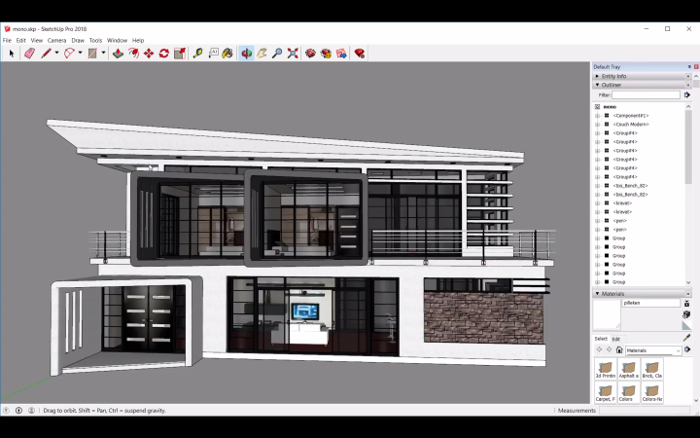Greg Corke talks to Epic Games Enterprise about the potential of Unreal Engine in AEC and its ambition to make the real time game engine an essential tool for the design process
Unreal Engine is making big strides in architectural visualisation. The CGarchitect survey from February 2018 revealed that 21% of viz artists were using the real time game engine in production, double that from 2017.
Next year we expect these numbers to grow again, fuelled in part by the recent beta launch of V-Ray for Unreal. By offering a push-button workflow from the leading arch viz rendering engine, barriers to adoption are being removed.
“You can actually use Unreal without learning Unreal, which is what customers told us they wanted,” says Marc Petit, General Manager, Epic Games Enterprise of the workflow that automatically transfers the entire scene — materials, lights and all — into the real time engine. “Suddenly, for the same amount of effort, they get to interactive content. They can stay in their favourite environment, do what they do, but they can now get interactive and immersive and VR for free.”
The future of Unreal Engine in creative agencies and viz studios certainly looks bright, but Epic Games is not happy for it to simply be a showcase tool for polished real time and VR experiences. It has much bigger ambitions for AEC.
“The big prize is to become part of the design process,” explains Petit, “and offer everything the platform does well — which is ingest super complex geometry, create high fidelity rendering, animation, physics, multi-user, immersion, VR support and AR support.”
Workflow is king
In architecture and engineering, designs continually change, so a workflow was needed to support this fluid process. If users had to re-apply textures, materials and lighting every time there was a new design iteration, Epic knew it would be fighting a losing battle. The cost of data preparation had to be eradicated.
To support its ‘enterprise’ users, Epic developed Unreal Studio, a suite of tools designed to make it easier to work with CAD and other 3D software. Unreal Studio is currently in beta and is free to download. The beta was recently extended to run until September 2019, when it will officially launch for a monthly subscription fee of around $50.
Unreal Studio includes a number of components, including templates, assets (materials), learning tools and professional support, but it’s the Datasmith workflow toolkit that is most important, as it streamlines the flow of data from CAD into the Unreal Engine Editor.
Datasmith works with a number of applications, including SketchUp Pro, Rhino, 3ds Max and SolidWorks, either through plug-ins or direct import. Support for other applications, including Revit, are also in development, as Petit explains. “Revit is such a closed environment, so it’s a tough nut to crack, but we’re working on it now.”
Unreal Studio 4.20, released in July this year, took a massive leap forward with the introduction of non-destructive workflows. Now, when a design model changes and is re-imported, any investment that has been made in Unreal Engine is maintained.
“There’s always a new version of the MEP model, a new version of the architectural model — and so the non-destructive workflow means that all the edits and decisions that you’ve made in Unreal get reapplied automatically when you reimport,” explains Petit. “Or we optimise — I mean if you re-import a hotel and you only change the door knobs, we’ll figure it out. We don’t need to re-import the doors and the walls, we’ll just re-import the door knobs. All of this optimisation helps you be more productive.”
Building on the foundation of nondestructive workflows, the next step for Unreal Studio is to support live streaming between the design tools and Unreal Engine. This capability, which is earmarked for release later this year, should have a massive impact on how Unreal is embraced throughout the design process. Architects, engineers or clients alike will be able to instantly visualise the impact of design changes in the visually rich Unreal environment, a feature that has made tools like Enscape so popular with architects.
“We already do it for Maya — live streaming — and we are now going to bring it to products like SketchUp. So, you can actually have someone in the workflow modelling in SketchUp, streaming to the engine,” explains Petit. “We needed the non-destructive workflow first because it’s a form of live update. You don’t read from a file, you read from a stream.”


Data optimisation
In 3D games, datasets undergo an incredible amount of optimisation to ensure good performance on screen and in VR. And, as long as the scene delivers the right look and feel, then geometry can be simplified dramatically.
AEC is different in that geometry generally needs to be very accurate, so designs are not over simplified. Furthermore, with designs continually evolving, firms don’t have the luxury of spending hours optimising every new dataset. The process is made more complicated if assets need to be simultaneously pushed out to different platforms — PC, mobile, VR or AR — and at various Levels of Detail (LoD), with different polygon budgets for quality and performance.
In short, the process needs a significant level of automation.
With Unreal Studio 4.20 users are now able to prioritise which objects can be heavily optimised and which should not be optimised, using a combination of metadata and Python scripts.
Petit recalls an issue on a recent customer project, “There was a big problem with the urinals in a s tadium because, for some reason in VR, it was not performing. We ran an analysis and we realised that there were a lot of urinals [with complex geometry] that were getting processed, not fully rendered, but processed.
“You can now tag those as second-class citizens. You can write a script that says, oh my god, this is not an important piece, I’m going to decimate the hell out of it.”
In many BIM workflows, metadata is prevalent, so standard classifications and scripts can be used across projects to help manage polygon budgets more effectively. However, Unreal is also exploring ways to harness the power of machine learning so Unreal Engine would be able to automatically ‘recognise’ objects and process them accordingly when metadata is not present or in the right format.
“Right now, a human would have to interpret the metadata but ultimately, you could have a very simple machine learning layer on top of it and say “It’s a screw, I don’t care about a screw, it’s going to be a cylinder. Or it could be used to add behaviours, like ‘this is a door of a certain type, and this is how it should open’.
“There are two things we are looking at,” adds Petit. “One is, of course, recognising shapes. You can tell that a cup is a cup, and you then have strategies to optimise a cup. We could also start to develop semantics around some metadata and start to automate decision making based on that.”
Petit is keen to emphasise any discussions on machine learning are very prospective and acknowledges that object recognition is very complex, “You can train a machine to recognise a screw, but you need a lot of data, you need to show it a lot of screws and we haven’t worked out who we partner with to do that aspect.”
The learning curve
Unreal Engine is a very powerful tool; the rendering quality is superb and due to get even better with the promise of real time ray tracing using Nvidia RTX technology. But it is also known for its complexity and steep learning curve. It is also important to understand that Unreal Engine is a software development platform, for creating a game or an application, and not an off-theshelf software tool. This makes it very different to something like Enscape, which is designed specifically for architects and laser-focused on ease of use. And while large architectural practices have the luxury of in-house viz teams with the advanced programming skills needed to get the most out of the software, smaller firms need more hand holding.
Epic Games acknowledges this and is working hard to help newcomers get up and running quickly. With SketchUp, for example, providing that the SketchUp assets are well modelled and the materials applied correctly, the plug-in automatically translates cameras, materials, and geometry into Unreal Engine assets.
Unreal Studio also includes templates to use as a starting point for architectural projects into which users can simply drop their model. Then, by using Blueprint, Unreal’s visual scripting language, users can go on to add life to a scene, as Simon Jones, Director, Unreal Engine Enterprise explains. “Blueprint is modular, so we can have libraries. If you want to create some function in a scene, let’s say you want the door to swing and you want it to make a noise while it swings and maybe cast light into the scene as it reflects light, now, that could be a blueprint that exists somewhere in a library that you just lift to drop into your scene and apply it to that object, that door.”
Jones is adamant that Epic Games is not going to introduce multiple versions of Unreal Engine, say one for architectural visualisation, another for auto design. “We can never genuinely predict what features people will use,” he says “It would be arrogant of us, probably foolish of us, to eliminate features that other industries are using,” citing virtual production TV and film techniques, such as green screens, as examples of features that are increasingly being used in design viz.
“We may introduce a templated front end, so you can select, as you fire up the engine, that you’re an architect — and maybe later you can say what type of architect you are, maybe how advanced you are — and then we’re going to present to you the way to use the engine in the way that you understand it.
“For example, we might start you off with a scene that looks like a room, and you can bring in your own content and adapt it. We might pre-load some materials that are addressable for you — a library. But you’ll always be able to go back [and use all the features if you wish].”
Even with this hand holding, some will still find Unreal Engine too complicated for their needs. And it’s here that thirdparty developers look set to play an increasingly important role.
Twinmotion, the real time visualisation and VR tool designed for architects, is a prime example. The latest release, built around Unreal Engine, is designed to be easy to use and offers live links to Revit and ArchiCAD.
Epic Games is actively looking for more third-party developers to bring industry-specific workflow expertise to the game engine and makes the source code freely available. “We acknowledge that every market segment has real problems [workflow challenges] and they deserve to have dedicated applications,” says Petit. “We want to partner with the people that are going to bring those dedicated applications.”
The obvious value for third party developers is access to an extremely high quality, high performance game engine, but the benefits don’t end there. Unreal Engine offers out of the box support for VR (with HMDs and CAVES) and AR for use on the construction site. There is also a huge potential for collaborative design across distributed teams, as Petit explains, “It’s a game engine and has all the features for collaboration — voice chat, multi user.”
Unreal Engine could even be used to perform roles traditionally carried out by engineering-focused products like Navisworks, “We don’t have clash detection out of the box, but our physics engine is really good,” says Petit, adding that there are also prototypes for cutting planes / live sections.
The aggregation platform
Epic Games has a long-term ambition for Unreal Engine to become a hub for all AEC data throughout the design process and beyond, “We’re seeing this in construction already, people are assembling MEP models, architectural models, structural models and using Unreal Engine as an aggregation platform.”
Petit also believes the co-ordinated model should not be limited to visualisation. “Right now, you aggregate in 3ds max and do a beautiful picture and aggregate in Navisworks to make all the decisions.
“People will soon realise they can do this in the same platform; it will generate a lot of saving.”
And those savings could potentially be huge. The notion of using a single asset that could be adapted to different workflows as and when required, supporting engineering and aesthetic decision making throughout the design process, is incredibly powerful. The visual fidelity of the engine may grab the headlines, but the way in which it can handle colossal datasets in multi-user environments promises to deliver a strong foundation for collaborative AEC workflows.
Petit acknowledges the engine is not yet ready to take up the mantle as the allencompassing multi resolution, multipurpose generator of ‘digital twins’, “We need more data types, we could be better at terrain, we could be better at point clouds, we still have work to do, but the premise and the promise are very good. The potential is overwhelming,” he concludes.
Unreal Engine – how much does it cost?
There is a lot of confusion surrounding licensing for Unreal Engine and how much it costs. In short, anyone can use the engine for free, but if you make a product that you sell – a game, for example – you pay a royalty on those transactions.
As design viz doesn’t involve the creation of commercial products, no royalties are applicable and architects and creative agencies needn’t pay a dime if they don’t wish to.
However, those who place a value on professional ticketed support, viz templates, materials, tutorials and the nondestructive CAD-to-Unreal Datasmith workflows, will need an Unreal Studio subscription.
Unreal Studio launches officially in September 2019 and will start from $49 per month, which seems money well spent. The beta is currently free. Epic
Games Enterprise also offers bespoke licensing agreements for larger firms that may need special help with pipelines, custom workflows, support plans or simply need changes to the Unreal Engine Studio EULA (End User License Agreement).
If you enjoyed this article, subscribe to our email newsletter or print / PDF magazine for FREE






